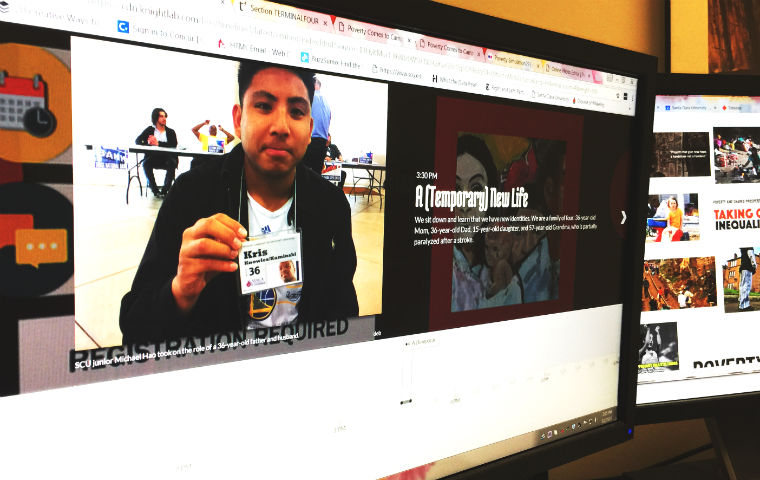
For an hour and a half one recent weekday, Santa Clara University's Locatelli Student Activity Center became a microcosm of the life that an estimated 336,000 people in Santa Clara County experience each day. The event was intended to help participants empathize more acutely across the growing divide of inequality between rich and poor in the United States. What is it really like to live with the constant risk of losing your home, or with no extra money for school supplies or preventative health care? What choices does that require? What does it do to your family unit?
The Community Action Poverty Simulation was sponsored by the Markkula Center for Applied Ethics at Santa Clara University, and put on by Step Up Silicon Valley (an anti-poverty laboratory arm of Catholic Charities) with help from resource volunteers from Downtown Streets Team.
Below is an interactive timeline with highlights from the event from one of the four-member teams - composed of SCU students, staff, and others from the community -- who participated. Below that, some observations that emerged from the post-simulation reflection period.
TIMELINE OF POVERTY SIMULATION
TAKEAWAYS
Poverty necessitates short-term thinking. Faced with not covering our mortgage, it didn’t seem too bad to hock our TV or camera. We really thought we’d pay back those neighbors for those vouchers. Grandma’s flu shot would have required travel money, waiting time, and a fee, so that was nixed fast.
Money-- or the lack of it-- loomed large. “It was really striking - all our conversations were about money, ” observed participant David DeCosse of the Markkula Center. “It was interesting how much space that topic occupied, crowding out possibilities for other things: play, affection, whatever.”
Setbacks hurt. It didn’t even matter how much repairs would cost for that broken window; we didn’t have the money. When the organizer with the “luck of the draw” cards came by, we cringed, knowing any setback would make a nearly impossible financial situation even more desperate. Losing our home was a real threat.
Red tape feels like the enemy. We wanted to throttle the bank teller who made Dad jump through hoops to cash his check, when so much was riding on that cash. The real- life person playing the Social Services agent, a volunteer from Downtown Streets Team, said bureaucracy is a real part of poverty. “It felt good to say ‘No, you have to come back tomorrow,’ because that’s what we deal with in real life on a daily basis,” she said.
Poverty is stressful. It became clear that the infrastructures of our society assume people have time, disposable income, and flexibility if things go wrong. We had none of those. As Patrick Scott from Downtown Streets Team said “so many things are a lot easier said than done.”
Safety-net agencies are a blessing. Not only did the Community Action Agency come through with vouchers for a week of groceries, we found out after the simulation that the Interfaith Center had money, bus passes, and other items available we could have accessed for free.
Poverty is extremely close by. The homeless members of Downtown Streets Team, who shared tips and challenges they face daily, made the exercise far more vivid. And Santa Clara University senior Neely Shachal said her own boyfriend “has struggled through poverty and homelessness for parts of his life.” She was attending to get a small sense of his experience, and to help her write a paper for class.
Those who don’t have to endure this life are lucky.